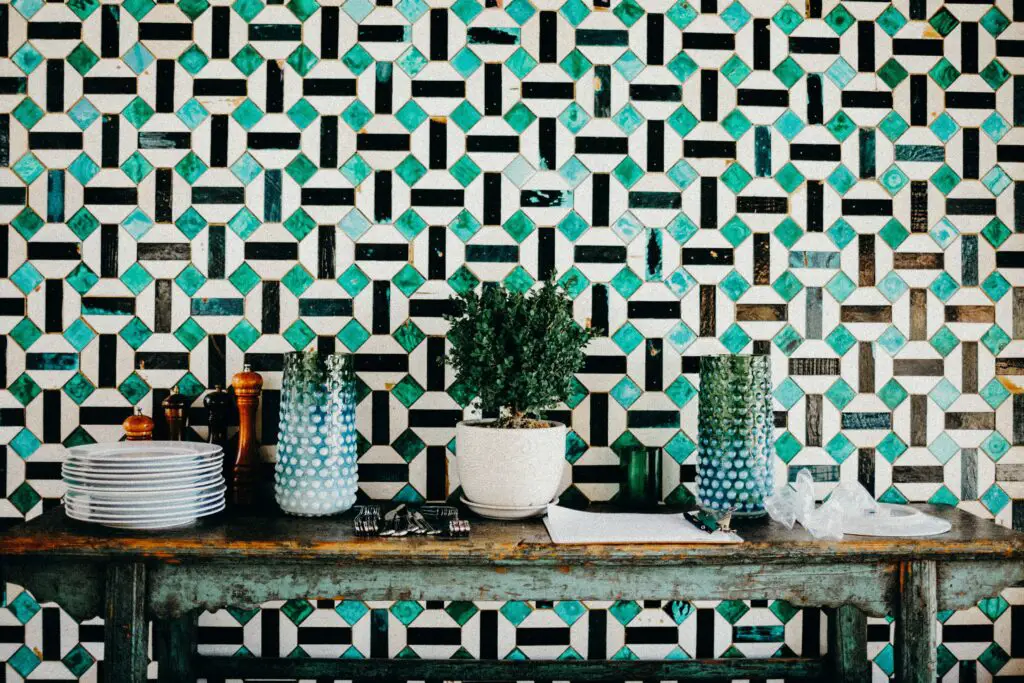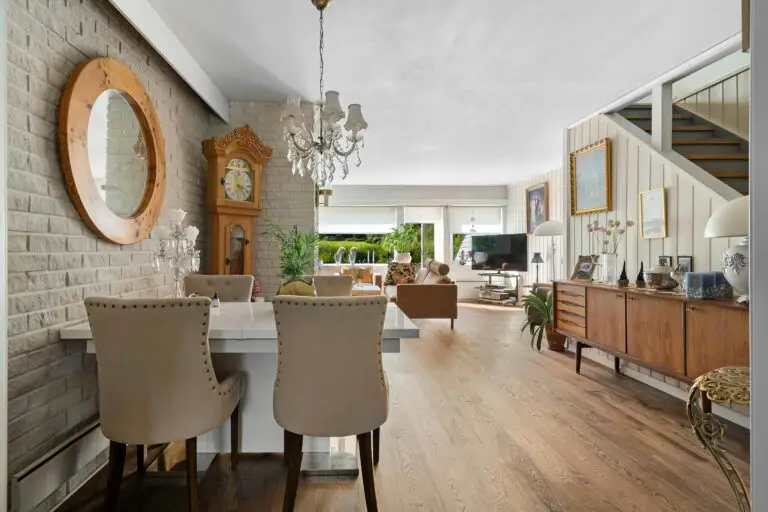Contemporary interior design embraces innovation, creativity, and a harmonious blend of aesthetics and functionality. One powerful element that has gained significant popularity in recent years is the use of geometric patterns. Geometric patterns bring a sense of structure, order, and visual interest to any space, making them an ideal choice for modern interiors.
In this blog post, we will delve into the world of geometric patterns in contemporary interior design and explore various ways to incorporate them into your living spaces.
What are Geometric Patterns?

To fully appreciate the impact of geometric patterns in contemporary interior design, it’s essential to understand their definition and characteristics.
Geometric patterns are based on mathematical principles, featuring precise shapes such as lines, angles, and curves. They can be symmetrical, angular, or even organic, offering a wide range of design possibilities.
Geometric patterns have a rich historical significance, dating back to ancient civilizations and finding their way into art, architecture, and design. In contemporary interior design, geometric patterns add depth, dimension, and a sense of modernity to any space.
Types of Geometric Patterns

1. Symmetry and Repetition
Symmetrical geometric patterns, such as tessellations and mirrored designs, can create a sense of balance and order. They offer a structured aesthetic that adds a touch of elegance to any room. Repetitive geometric patterns, on the other hand, provide rhythm and continuity. By using repeating shapes, lines, or motifs, you can establish a visual rhythm that draws the eye and creates a cohesive design.
2. Angular Geometric Patterns
Angular geometric patterns utilize sharp angles and lines to create a bold and dynamic visual impact. Incorporating shapes like triangles, squares, and polygons adds a contemporary and edgy feel to interior spaces. Whether through angular wall decals or furniture with geometric frames, these patterns can infuse your design with a modern and sleek vibe.
3. Curved and Organic Geometric Patterns
Contrary to the strictness of angular patterns, curved and organic geometric patterns introduce softness and fluidity into contemporary interior design. These patterns emulate nature’s organic forms, such as waves or spirals. By incorporating curved lines and shapes into your design, you can strike a balance between the rigidity of angular patterns and the natural flow of organic elements, creating a harmonious and inviting space.
4. Dimension and Depth
Geometric patterns can create a sense of depth and dimension in interior design. Layered geometric patterns, such as overlapping shapes or intricate cutouts, add visual interest and texture to walls, floors, or ceilings. Three-dimensional geometric patterns, achieved through sculptural elements or textured surfaces, offer a tactile and immersive experience. These techniques can transform an ordinary space into a captivating environment.
Applying Geometric Patterns in Contemporary Interior Design

Now that we’ve explored the different types of geometric patterns, let’s discuss how to apply them to various aspects of contemporary interior design.
1. Walls and Floors
Geometric patterns can dramatically transform the look and feel of walls and floors. Consider using geometric wallpaper or wall coverings to make a bold statement. Alternatively, opt for geometric tiles or flooring patterns to create visually stunning surfaces. These patterns can be used in entire rooms or as accent walls, adding depth and personality to your living spaces.
2. Furniture and Upholstery
Furniture plays a significant role in interior design, and incorporating geometric patterns into your furniture choices can instantly elevate the overall aesthetic. Look for chairs, sofas, and tables with geometric frames or patterns. Additionally, using upholstery featuring geometric motifs or textures can provide a focal point and enhance the visual appeal of your furniture pieces.
3. Lighting and Accessories
Lighting fixtures and accessories present excellent opportunities to introduce geometric patterns into your design scheme. Look for pendant lights, chandeliers, or floor lamps with geometric shapes, adding a modern and artistic touch to your lighting arrangements. Furthermore, accessories such as geometrically patterned rugs, cushions, or artwork can infuse your space with character and style.
4. Color and Contrast
Color plays a crucial role in interior design, and when combined with geometric patterns, it can create impactful visual effects. Consider contrasting colors to enhance the geometric patterns in your space. For example, pairing black and white with bold geometric designs can create a striking and sophisticated atmosphere. Alternatively, harmonizing colors within a geometric pattern can produce a more serene and cohesive ambiance.
Creating Balance and Harmony

While incorporating geometric patterns can be visually captivating, achieving balance and harmony is essential to avoid overwhelming your space. Consider the following tips:
1. Proportions and Scale
Pay attention to the proportions and scale of your geometric patterns. Balancing different scales of patterns ensures a harmonious and visually appealing result. For instance, combining large-scale geometric patterns with smaller, more intricate ones can create an interesting and balanced composition.
2. Mixing Patterns
Mixing multiple geometric patterns can be a design challenge. To achieve a cohesive look, consider sticking to a limited color palette or selecting patterns with similar shapes or themes. Finding a common thread between patterns helps create a harmonious and unified space.
3. Creating Focal Points
Geometric patterns can be used strategically to draw attention to specific areas or architectural features in your space. Whether it’s a geometric accent wall, a bold patterned rug, or an eye-catching piece of furniture, using geometric patterns as focal points adds visual interest and depth.
4. Residential Spaces
In living rooms and bedrooms, geometric patterns can transform a plain space into a modern and stylish haven. Experiment with geometric wallpaper, rugs, or cushions to infuse personality into these areas. Kitchens and dining areas can benefit from geometric tile backsplashes, cabinetry with geometric patterns, or dining tables with geometric bases.
5. Commercial Spaces
Offices, co-working spaces, retail stores, and cafes can all benefit from the use of geometric patterns. Incorporate geometric design elements into reception areas, feature walls, or furniture to create an inviting and trendy atmosphere that captivates customers and clients.
Conclusion
Geometric patterns offer endless possibilities for contemporary interior design. By understanding the different types of geometric patterns and how to apply them, you can create visually stunning and modern living spaces. From walls and floors to furniture and accessories, geometric patterns can transform your space into a true work of art.
Embrace the power of geometric designs, experiment with colors and textures, and let your creativity soar as you embark on your journey to achieve a harmonious and captivating interior design.
Frequently Asked Questions (FAQs)
1. Can you mix different geometric patterns in interior design?
Absolutely! Mixing different geometric patterns can add depth and visual interest to your space. Just ensure that there is a common thread, such as color or shape, to create a cohesive look. Experiment and have fun!
2. Are geometric patterns suitable for small spaces?
Yes, geometric patterns can work well in small spaces. Opt for smaller-scale patterns and lighter colors to avoid overwhelming the room. By strategically incorporating geometric patterns, you can create an illusion of depth and make your space appear larger.
3. How can you incorporate geometric patterns without making the design too busy?
To avoid a cluttered look, start with a neutral base and add geometric patterns as accents. Focus on one or two key areas, such as a feature wall or a statement piece of furniture. Remember, less is often more when it comes to incorporating patterns in your design.
4. Are geometric patterns a passing trend?
Geometric patterns have stood the test of time and continue to be a popular choice in contemporary interior design. While trends may evolve, geometric patterns offer a timeless appeal that can be adapted to various design styles. Embrace this versatile element and create a space that reflects your style.
5. Where can you find inspiration for incorporating geometric patterns in contemporary interior design?
You can find inspiration for incorporating geometric patterns in interior design through various sources. Online platforms such as design blogs, social media platforms like Pinterest, and interior design magazines can provide a wealth of ideas. Additionally, exploring furniture stores and galleries and attending design exhibitions can expose you to real-life applications of geometric patterns in interior design.



